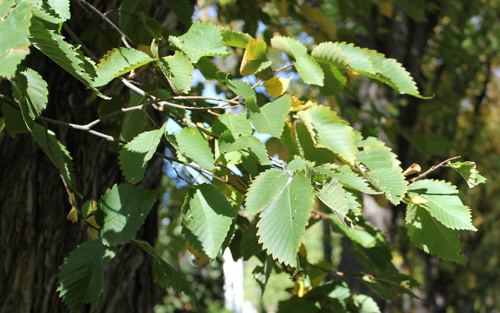Dutch Elm Disease
After reaching southeast Saskatchewan in the early 1990s DEDspread through native wild elm stands and rural communities. Saskatoon's first case (a Siberian Elm) occurred in 2015. All cases confirmed since then have been in American Elms, with a large jump in 2024. First identified in Holland in 1921, DED is a fungus spread by tiny elm bark beetles. The fungus blocks the tree's vascular system, causing rapid decline and death within one to several years. The beetles are attracted to the bark of freshly pruned, stressed, or dying elm trees, as well as freshly stored elm logs. The beetles dig galleries under the bark in which they lay eggs. If the tree or the cut wood is infected with DED, the emerged adult beetles carry DED spores. When those beetles dig galleries into the bark of healthy elms the spores rub off into the new tree. DED can also spread from infected trees to healthy ones via transmission among roots.
Siberian or Manchurian Elm, Ulmus pumila, common in Saskatoon, is a weedy species, smaller, much shorter lived, and more varied in form than the American Elm. It can be infected but not usually killed by DED, and Elm bark beetles can transfer DED from them to American Elms. Therefore, DED control is essential for BOTH Siberian and American Elm.
To prevent spread, the early signs of DED e.g. leaves on a branch of an elm tree wilting, curling, turning brown in late June, need to be reported to municipal authorities for sampling the inner bark of that branch and lab analysis to detect the DED fungus. Testing positive for DED, the tree must be completely removed, including the stump to 10cm below grade. All wood must immediately be disposed of at the landfill according to provincial regulations. Illegal transport of infected elm to use for firewood is the primary factor in the long distance spread of DED.
Efforts to combat the spread of DED include diligent surveillance to find, report, and confirm infections followed by rapid removal of infected trees. It is important to also have public education, and proactive maintenance to keep elms healthy and free of dead wood. In the historic spread of DED across North America most cities failed to promptly act against DED and soon lost all their American Elms. However, a few cities committed resources early to fight the disease and greatly slowed their rate of loss, through ongoing vigilance and rapid action.
Actions that people can take to help prevent the spread of DED into their communities include:
- Do not transport, sell, store or use elm firewood; it's against the law and one of the main ways that DED can spread.
- Dispose of elm wood properly at the site designated by your municipal authority. In Saskatoon it is at the City Landfill.
- Prune elm trees to keep them healthy — prune only in winter months outside the annual ban period (April 1 to August 31).
- Make sure the tree care professional you hire has the required training. They need to be International Society of Arboriculture (ISA) certified.
- Learn the signs and symptoms of DED and report anything that looks suspicious to local authorities.
In Saskatoon call Urban Biological Services at 306-975-2890 or fill out their online form. You can also contact the Saskatchewan Government at the Inquiry Centre at 1-800-567-4224 or email centre.inquiry@gov.sk.ca.
For more information on DED: Saskatchewan Government or SOS Trees Coalition.
